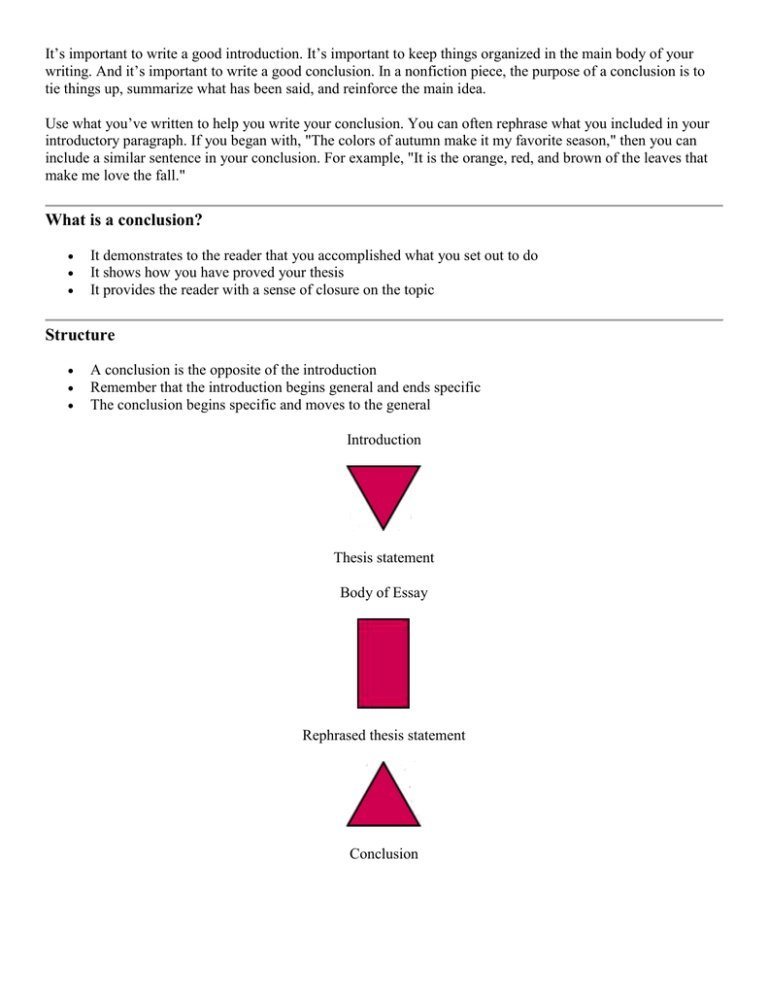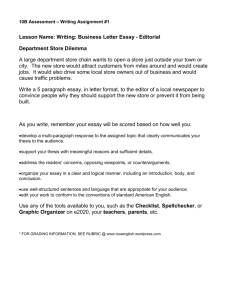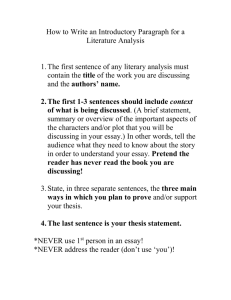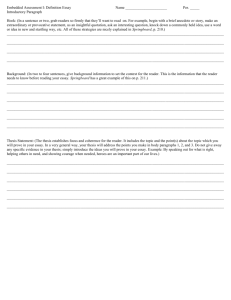Writing A Conclusion
advertisement

It’s important to write a good introduction. It’s important to keep things organized in the main body of your writing. And it’s important to write a good conclusion. In a nonfiction piece, the purpose of a conclusion is to tie things up, summarize what has been said, and reinforce the main idea. Use what you’ve written to help you write your conclusion. You can often rephrase what you included in your introductory paragraph. If you began with, "The colors of autumn make it my favorite season," then you can include a similar sentence in your conclusion. For example, "It is the orange, red, and brown of the leaves that make me love the fall." What is a conclusion? It demonstrates to the reader that you accomplished what you set out to do It shows how you have proved your thesis It provides the reader with a sense of closure on the topic Structure A conclusion is the opposite of the introduction Remember that the introduction begins general and ends specific The conclusion begins specific and moves to the general Introduction Thesis statement Body of Essay Rephrased thesis statement Conclusion What to include Your conclusion wraps up your essay in a tidy package and brings it home for your reader Your topic sentence should summarize what you said in your thesis statement o This suggests to your reader that you have accomplished what you set out to accomplish Do not simply restate your thesis statement, as that would be redundant o Rephrase the thesis statement with fresh and deeper understanding Your conclusion is no place to bring up new ideas Your supporting sentences should summarize what you have already said in the body of your essay o If a brilliant idea tries to sneak into the final paragraph, you must pluck it out and let it have its own paragraph in the body, or leave it out completely Your topic for each body paragraph should be summarized in the conclusion o Wrap up the main points Your closing sentence should help the reader feel a sense of closure Your closing sentence is your last word on the subject; it is your "clincher" o Demonstrate the importance of your ideas o Propel your reader to a new view of the subject o End on a positive note Your closing sentence should make your readers glad they read your paper Strategies for an effective conclusion Play the "So What" Game. o When you read a statement from the conclusion, ask yourself, "So what?" or "Why should anybody care?" o Ponder that question and answer it Basically, I’m just saying that education was important to Douglass So what? Well, it was important because it was a key to him feeling like a free and equal citizen Why should anybody care? That’s important because plantation owners tried to keep slaves from being educated so that they could maintain control. When Douglass obtained an education, he undermined that control personally. Return to the theme or themes in the introduction o This brings the reader full circle o If you begin by describing a scenario, you can end with the same scenario as proof that your essay is helpful in creating a new understanding o Refer to the introductory paragraph by using key words, or parallel concepts and images that you also used in the introduction Summarize o Include a brief summary of the paper’s main points, but don’t simply repeat things that were in the paper Pull it all together o Show your reader how the points you made and the support and examples you used fit together Include a provocative insight or quotation from the research or reading you did for the paper Propose a course of action, a solution to an issue, or questions for further study Point to broader implications o A paper about the style of writer, Virginia Woolf, could point to her influence on other writers or later feminists




